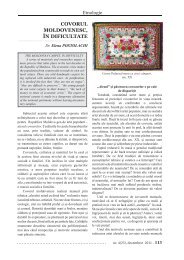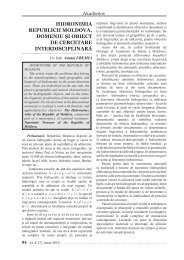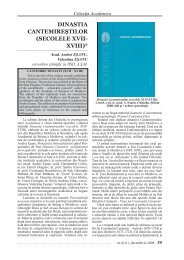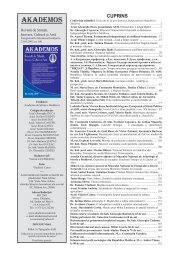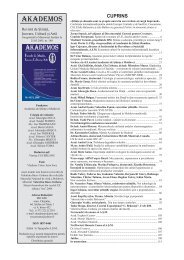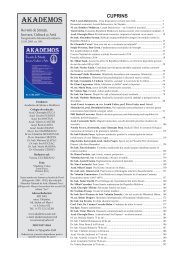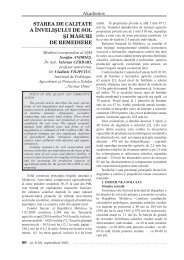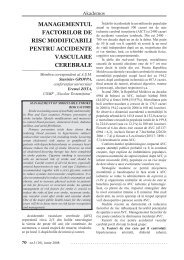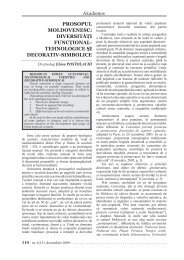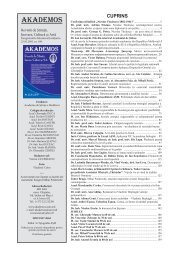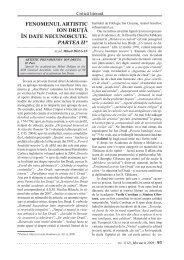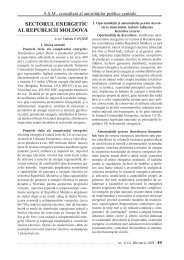Academos 3 2008.indd - Akademos - Academia de ÅtiinÅ£e a Moldovei
Academos 3 2008.indd - Akademos - Academia de ÅtiinÅ£e a Moldovei
Academos 3 2008.indd - Akademos - Academia de ÅtiinÅ£e a Moldovei
You also want an ePaper? Increase the reach of your titles
YUMPU automatically turns print PDFs into web optimized ePapers that Google loves.
<strong>Aka<strong>de</strong>mos</strong><br />
SOS HONEY<br />
BEE: DETECTION<br />
OF FOUR HIGHLY<br />
PATHOGENIC BEE<br />
VIRUSES IN APIARIES<br />
FROM REPUBLIC OF<br />
MOLDOVA<br />
Acad. Ion TODERAS 1 ,<br />
scientifi c researcher Alexandru<br />
MOVILA 1 ,<br />
Ph.D. Laurent GAUTHIER 2 ,<br />
Professor Max BERGOIN 2 ,<br />
scientifi c researcher Natalia<br />
MUNTEANU 1 ,<br />
acad. Valeriu RUDIC 3 ,<br />
licentiate Tatiana OBOROC 1 ,<br />
Ph.D. François COUSSERANS 2 ,<br />
scientifi c researcher Na<strong>de</strong>jda<br />
RAILEAN 1<br />
1 – Center for General and Molecular Biology, Institute<br />
of Zoology, Moldova Aca<strong>de</strong>my of sciences<br />
2 – Laboratoire <strong>de</strong> Pathologie Comparée <strong>de</strong>s Invertébrés,<br />
Université Montpellier II, Montpellier, France<br />
3 – Institute of Microbiology and Biotechnology,<br />
Moldova Aca<strong>de</strong>my of Sciences<br />
ALBINA MELIFERĂ ÎN PERICOL:<br />
IDENTIFICAREA A 4 VIRUSURI<br />
PATOGENE PENTRU ALBINELE DIN<br />
REPUBLICA MOLDOVA<br />
In colaborare cu savanţii celui mai prestigios<br />
Centru <strong>de</strong> Excelenţă din Franţa prin aplicarea<br />
meto<strong>de</strong>lor molecular-genetice, în premieră<br />
pentru Republica Moldova, a fost <strong>de</strong>monstrată<br />
prezenţa a patru ARN-virusuri cu consecinţe<br />
nefaste pentru familiile <strong>de</strong> albine, vectorul<br />
transmisibil fi ind acarianul Varroa <strong>de</strong>structor.<br />
De remarcat că până în prezent în lume sunt<br />
cunoscute 18 virusuri care afectează stupunele<br />
albinelor.<br />
Introduction<br />
The scientific interest in viral diseases of the<br />
honeybee (Apis mellifera L.) has been increasing<br />
consi<strong>de</strong>rably during the past few years. At least 18<br />
different viruses have been <strong>de</strong>tected in honeybees<br />
so far. Viruses in certain cases may cause serious or<br />
even lethal disease in individual bees or the collapse<br />
of entire colonies without clinical symptoms [1].<br />
Infestation with the ectoparasitic mite Varroa<br />
<strong>de</strong>structor is the major predisposing factor [3, 6];<br />
however, a variety of other weakening circumstances<br />
may play a role in clinical manifestation of bee<br />
virus infections (e.g., Nosema apis infestation,<br />
intoxications, environmental pollution, and cold<br />
weather) [1].<br />
In practical terms, six viruses are consi<strong>de</strong>red to<br />
be able to cause severe disease in honeybees, and<br />
hence they are most important in beekeeping. These<br />
are sacbrood virus (SBV), chronic bee paralysis<br />
virus (CBPV), black queen cell virus (BQCV),<br />
<strong>de</strong>formed wing virus (DWV), acute bee paralysis<br />
virus (ABPV), and Kashmir bee virus (KBV).<br />
The study of the impact of viral diseases on honey<br />
bee colonies suffers from a lack of data concerning<br />
bee virus prevalence, particularly in asymptomatic<br />
colonies. The great diversity of viruses isolated<br />
from honey bees, the lack of specific clinical signs<br />
and the limited availability of tools for rapid and<br />
large-scale diagnoses are partially responsible for<br />
this situation. Complete or partial sequencing of<br />
several RNA viruses of the honey bee has allowed<br />
the recent <strong>de</strong>velopment of highly sensitive methods<br />
for <strong>de</strong>tection based on amplification by reverse<br />
transcription-PCR (RT-PCR) of specific viral<br />
sequences. Originally <strong>de</strong>veloped for diagnosis of<br />
human and animal RNA viruses, these methods have<br />
been successfully adapted to i<strong>de</strong>ntify several RNA<br />
bee viruses, including SBV, KBV, CBPV, ABPV,<br />
BQCV, and DWV [5, 8, 9, 10].<br />
We report here the first survey of the prevalence<br />
of bee RNA viruses in different apiaries from<br />
Republic of Moldova based on large-scale sampling<br />
of adult bees, brood, and varroa mites.<br />
Material and Methods<br />
Bee and varroa mite sampling. Beekeepers from<br />
different parts of the Republic of Moldova submitted<br />
bee samples from colonies suffering from symptoms<br />
of <strong>de</strong>population, sud<strong>de</strong>n collapse, paralysis or dark<br />
color, and varroa infestation.<br />
Sample preparation and PCR analysis. The<br />
frozen samples were crushed in a mortar in the<br />
presence of liquid nitrogen and were homogenized<br />
82 - nr.3 (10), iunie 2008



